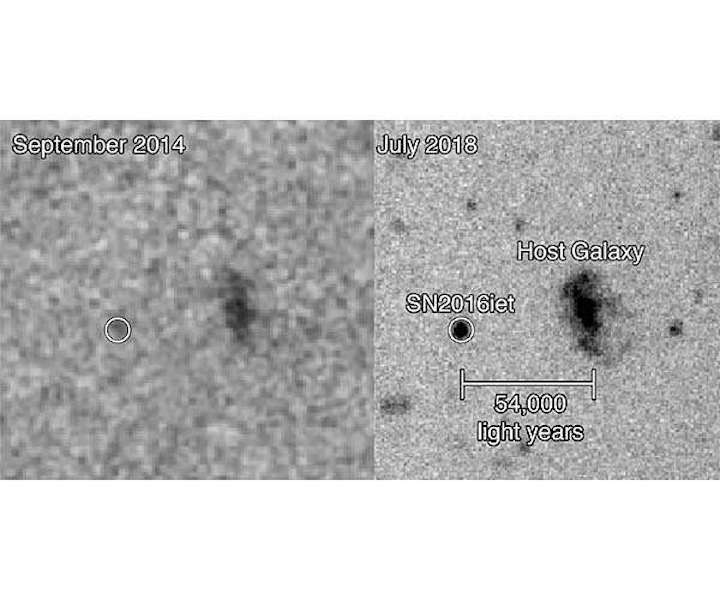26.08.2019

SN2016iet as first observed in September 2014 compared against July 2018 observations which revealed the host star's 54,000 light year distance from the host galaxy.
Scientists at the Center for Astrophysics | Harvard and Smithsonian have announced the discovery of the most massive star ever known to be destroyed by a supernova explosion, challenging known models of how massive stars die and providing insight into the death of the first stars in the universe.
First noticed in November 2016 by the European Space Agency's (ESA) Gaia satellite, three years of intensive follow up observations of the supernova SN2016iet revealed characteristics - incredibly long duration and large energy, unusual chemical fingerprints, and an environment poor in metals - for which there are no analogues in the existing astronomical literature.
"When we first realized how thoroughly unusual SN2016iet is my reaction was 'whoa - did something go horribly wrong with our data?'" said Mr. Sebastian Gomez, Harvard University graduate student and lead author of the paper. "After a while we determined that SN2016iet is an incredible mystery, located in a previously uncatalogued galaxy one billion light-years from Earth."
The team used a variety of telescopes, including the CfA | Harvard and Smithsonian's MMT Observatory located at the Fred Lawrence Whipple Observatory in Amado, AZ, and the Magellan Telescopes at the Las Campanas Observatory in Chile to show that SN2016iet is different than the thousands of supernovas observed by scientists for decades.
"Everything about this supernova looks different - its change in brightness with time, its spectrum, the galaxy it is located in, and even where it's located within its galaxy, said Dr. Edo Berger, Professor of Astronomy at Harvard University and an author on the paper. "We sometimes see supernovas that are unusual in one respect, but otherwise are normal; this one is unique in every possible way."
The observations and analysis show that SN2016iet began as an incredibly massive star 200 times the mass of Earth's Sun that mysteriously formed in isolation roughly 54,000 light-years from the center of its host dwarf galaxy.
The star lost about 85 percent of its mass during a short life of only a few million years, all the way up to its final explosion and demise. The collision of the explosion debris with the material shed in the final decade before explosion led to SN2016iet's unusual appearance, providing scientists with the first strong case of a pair-instability supernova.
"The idea of pair-instability supernovas has been around for decades," said Berger. "But finally having the first observational example that puts a dying star in the right regime of mass, with the right behavior, and in a metal-poor dwarf galaxy is an incredible step forward. SN2016iet represents the way in which the most massive stars in the universe, including the first stars, die."
The team will continue to observe and study SN2016iet for years, watching for additional clues as to how it formed, and how it will evolve. "Most supernovas fade away and become invisible against the glare of their host galaxies within a few months. But because SN2016iet is so bright and so isolated we can study its evolution for years to come," said Gomez. "These observations are already in progress and we can't wait to see what other surprises this supernova has in store for us."
